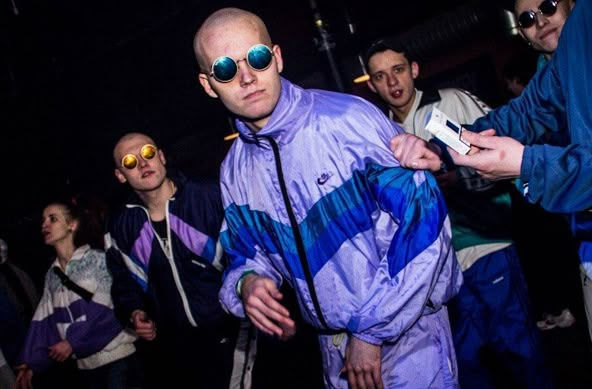

Two decades on from its release “UK Electro” is regarded as a cult-classic by the thriving British Retro–Electro community, many of whom were barely in their teens when the album was issued (via Street Sounds, the label that introduced so many young people to dance culture in this country). It was the first record I worked on (as co-writer, co-producer and mixer/remixer), and was released in June ‘84, 6 months after I retired as a club DJ at the end of 1983.
In January 1984, I sat down with Kermit and Fiddz, two of the dancers from Broken Glass, and we wrote the lyrics of a track called “Style Of The Street”. Following the Rock Steady Crew’s chart success we figured that we might be able to get a deal for a record of our own, so, along with Martin Jackson (ex-Magazine) and Andy Connell (the keyboard player from Factory band, A Certain Ratio), we went into a small studio in Knutsford and made a demo of “Style Of The Street”, so I could approach record companies with the idea.
Broken Glass ‘Style Of The Street’ – Unreleased demo version
One of the people we went to see was Morgan Khan, who I’d already built up a relationship with during my time as a DJ. In October ‘83 Morgan had launched his hugely successful “Street Sounds Electro” series, bringing the music to a mass UK audience for the first time. On hearing “Style Of The Street” and a couple of other ideas Martin, Andy and I had been working on, he offered us a deal and sent us back into the studio to master the Broken Glass track and record some new ones. Once he’d heard what we’d come up with, Morgan told us he wanted to release an album called “UK Electro”, using 6 of our tracks, plus a further track that Mastermind (who mixed the “Electro” albums) recorded under the name of The Rapologists. To give the illusion of a thriving Electro scene developing in Britain, he asked us think up different artist names (besides Broken Glass, these would be Zer-o, Forevereaction, and Syncbeat). Morgan came up with all the colourful aliases that appeared as the various production and songwriting credits, and the album was rush released in June ‘84, reaching a highly creditable number 60 on the UK chart.

Morgan Khan – 1984
The tracks themselves were diverse and experimental; we’d pretty much made them up in the studio as we went along. None of the keyboards were sequenced, with Andy, an excellent pianist, playing them all in. My own experience of recording studios was minimal, and now here we were making an Electro album! My naivety no doubt annoyed the hell out of Martin and Andy and the session became quite stressful as we tried to make sense of each other, but we somehow got through it all. The results, I feel, were interesting but patchy, but the album has its moments and, given the circumstances, I think we did quite well. “Style Of The Street” sounded like exactly what it was; a first and not very successful attempt at writing a Pop/Dance song (it sounded much better as a demo, before we’d over–electrofied it). The Forevereaction tracks were dark and brooding with strange sounding samples, whilst the two versions of “Real Time” by Zer–o had a funkier edge. The track that received the best response was “Music” by Syncbeat, which was full of good vibes and could have easily been re-vamped down the line as a House track.

UK Electro promo shot 1984
The white ‘rock press’ and ‘style magazines’ had recently begun to latch onto Electro, no doubt due to the Street Sounds compilations. The Face announced “Electro – The Beat That Won’t Be Beaten”, across a loud bright yellow cover in June ‘84, just ahead of the release of “UK Electro”, and suddenly we were receiving much interest and acclaim from these unexpected sources.

Further to the album, Morgan wanted to release 3 singles, and he hooked us up with New York engineer Craig Bevan (who had worked on the B Boys tracks and would later hook up with cut ‘n’ paste guru, Steinski, to create “The Motorcade Sped On”) so we could put some remixes together. I enjoyed working with Craig and learnt a lot from the session. I extensively edited these new mixes together and, hot on the heels of the album, Morgan simultaneously issued 12″ singles by Syncbeat, Broken Glass and Forevereaction on his Streetwave label.
Syncbeat ‘Music’
Neither made any impact on the chart, Streetwave ultimately not being geared to the singles market. The response, as with the album, was mixed, ranging from love it to hate it. It was too abstract for the breakers and the Soul crowd obviously hated Electro regardless of its origin, so it received little attention in the black press. But some journalists went for it in a big way. Dylan Jones, nowadays editor of GQ and a columnist with The Observer, interviewed Martin, Andy and I for a full page Record Mirror feature entitled “British Electro Foundations?”. He was a big fan of the project, and the following month he reviewed the Syncbeat 12” as the magazines record of the week. He wrote,
…it’s been lifted and remixed from the UK Electro album, and paves the way for likeminded British artists…simply because it’s so good it can’t be ignored…
At the end of the year he included UK Electro amongst his highlights of ‘84. In contrast, Paul Simpson of No 1 magazine regarded Syncbeat as “…too clever – too arty by half…”.
Melody Maker and Sounds were particularly (and surprisingly) supportive, with features and reviews. One of the main themes that the journalists picked up on was the novelty of a British DJ (or more precisely, ex-DJ) making rather than playing dance records, for this was something of a rarity back then (despite the fact that legendary Blackpool Mecca DJ, Ian Levine, had been doing this since the mid-70s). This only added to the growing tension between Martin and myself, especially when a review in Melody Maker described the project as “…the work of Manchester DJ Greg Wilson and sidekicks…”. I cringed when I read it and knew that this would go down like a lead balloon. I obviously had no control over what the journalists wrote, but Martin took umbrage and would soon decide that he’d had enough, combining with Andy to create an altogether different type of music, eventually tasting success with the softer tones of Swing Out Sister. It was sad that it had ended this way, I’d become pretty friendly with Martin before the rot set in and our egos clashed. We ultimately had different agendas, each of us being fairly intense characters who generally wanted our own way. It was my first time working with musicians (as it was Martin’s working with a DJ) and very much a learning curve for me, on both a musical and a personal level.
Our final fling was at the prestigious ICA in London. Amazingly we’d been asked to perform on the opening night of their annual “Rock Week”. This would be UK Electro’s one and only gig, featuring Broken Glass and topped off with another London break challenge, this time from a crew called the Zulu Rockers (following on from Sidewalk at Camden Palace the previous December). Lynden Barber summed it up in Melody Maker when he commented,
…whoever thought of presenting the team at the ICA should be both congratulated for breaking out of the usual ‘rock gig’ restrictions and castigated for trying to present what is in essence a studio music on stage.…

UK Electro at The ICA – Backstage Pass
At the end of the day UK Electro was an idea ahead of its time, hastily put together, which no sooner had it begun, ended. All in all it was a mad little period!
Street Sounds ad 1984 (Click image to enlarge)





